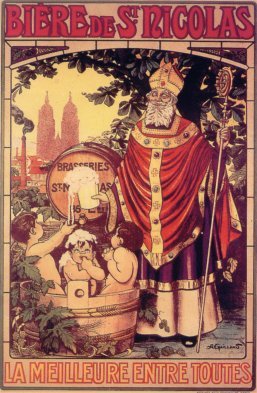The Real St Nicholas

Today Harrods opened its Christmas World section, the London store's earliest ever Christmas launch. And, of course, Santa Claus made a guest appearance, wearing his summer safari outfit and accompanied by a zebra (was the weather too hot for Rudolph?).
There was nothing fluffy about St Nicholas. When I was in Bari last week, there were no sentimentalised images of the saint; he actually came across as a manly, passionate defender of Truth and a powerful intercessor in Heaven.
One of the main concerns of his life, for example, was fighting the heresy of Arianism. According to an early biography, ‘thanks to the teaching of St Nicholas, the metropolis of Myra alone was untouched by the filth of the Arian heresy, which it firmly rejected as a death-dealing poison.’ There is even a story of the saint attending the Council of Nicaea and becoming so angry at the blasphemies of Arius that he went over to the heretic and punched him in the face. The bishops imprisoned St Nicholas for his assault, depriving him of his Episcopal dignity and burning off his beard. However, in prison he was visited by Our Lord and Our Lady, who restored his office and set him free. It’s a great story, even though St Nicholas is not recorded as attending the great Council, but it says something about the saint’s zeal.
Another example of the saint’s ‘righteous anger’ was his order to cut down a tree dedicated to the goddess Diana, much to the fury of the Devil. A fine fresco in the saint’s basilica in Bari shows the saint wielding the axe himself (rather like St Boniface cutting down the Sacred Oak).
The people of Bari take St Nicholas very seriously indeed. In particular, there is a strong devotion to the 'manna' of St Nicholas, a liquid that is apparently produced from the saint's tomb. This is extracted every year on 9 May (Feast of the Translation of St Nicholas), diluted and distributed to pilgrims (especially the sick). Between 1954 and 1957 the bones were exhumed during the renovation of the crypt and exposed to the public. The bones were frequently seen to 'perspire' and a linen cloth that was in contact with the bones was found to be soaking wet. The holy manna is traditionally put inside specially painted bottles.
A tenth century Greek wrote that ‘the West as well as the East acclaims and glorifies him. Wherever there are people, his name is revered and churches are built in his honour. All Christians reverence his memory and call upon his protection.’ Last Thursday I celebrated Mass in the Roman Rite over St Nicholas' tomb (completed in 1089). It was a moving experience, although it was so hot that my perspiration formed a kind of 'manna of Fr Nicholas.' As soon as I had returned to the crypt sacristy, a Russian Orthodox service began in a side chapel which, since 1966, has been reserved for the use of the Eastern Churches. Last May, when Pope Benedict visited Bari on his first papal pilgrimage, he referred to 'fortunate Bari, a city that preserves the bones of St Nicholas, a land of encounter and dialogue with our Christian brethren of the East.' As a saint who unifies East and West, St Nicholas takes on a great deal more significance than the lightweight caricature who will be seen in shopping centres across the world in a few months time.
Labels: Saints



0 Comments:
Post a Comment
<< Home